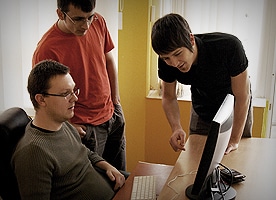As a freelance designer, I know the importance of accurately and continuously tracking time to know exactly how much I am going to charge the client when the project is done. It is also important for the client to be able to see exactly where I am in the process so that they know that everything is going according to plan. There is nothing more annoying for a client than when things drag out. The only thing you can do in that situation is to push through to get it all done. Of course, the most important thing of all is to keep the deadline and tracking your time is a great way to do that.
Looking around for an effective and easy-to-use time tracker isn’t exactly easy cause there are a ton of them out there. However, when I stumbled upon Paymo, a software launched back in 2007, I was quite excited. It’s one of those moments when you say, “I just have to check this one out cause it’s an online solution and that’s what really matters.”
The solution has had plenty of time to develop into a really strong and professional platform, and it does exactly what you want it to which is track time. There is no beating around the bush with a lot of fancy unnecessary inputs or buttons. It simply does one job and it does it well, it tracks the time you spend on each project you’re supervising.
I quickly initiated an interview with the crew behind it all, and they turned out to be the kind of people and company that fit in perfectly here on Bit Rebels. They’re driven geeks who really want to make your life easier and more enjoyable. If it’s ever a good time to express ourselves like Apple, it’s now… and this service helps you to just DO.

The idea for Paymo came out of an internal necessity back in 2007. At that point, our main business was an agency called Light Design Works. We did all sorts of projects (design, websites, coding) for various clients worldwide. As everyone else in this field of work, we were charging on an hourly basis. It quickly became apparent that we hated the tools we were using to track our time. We tried quite a few options over the years. The whole act of time tracking became a pain, it was hard to manage and simply took too much time and effort to get the results we wanted. Our ideal app would have to fulfill the following needs:
- It had to web based.
- We needed a desktop app so employees could work easily with it, without having a browser window open all the time.
- It had to work on PCs and Macs since we had PCs and Apple stuff in our office.
- Reporting had to be a breeze.
- It had to show us who was underperforming.
After finding that there’s no app out there that could handle these tasks, we took matters into our own hands and decided to build an online intranet app that would fit our needs perfectly. The only problem was that we had to juggle this project along with ongoing work for our clients, so it took quite a long time to develop the initial version.
After it was built, and we saw how good it was, we decided to make it public. We tried to build a business around it. The way to go was the freemium model. We made it available for free to all freelancers and charged a small fee to companies that were in need of a solid time tracking tool.
We came up with Paymo because we wanted our customers to get PAID MORE by using our system. :) While running the agency business, we constantly ran into the problem that we were getting paid less than we were actually working. This was due to two facts:
- Our quotes were unrealistic because we didn’t have solid time tracking data. We always approximated the amount of time needed to finish certain tasks and in practice, these quotes were always lower than what we ended up doing.
- Certain clients had trouble understanding why tasks took longer than quoted and were not willing to pay for the extra work. Without detailed data that a time tracking app can provide we had a tough time presenting documented proof of what actually happened during development.
 2. I bet a lot of people are wondering how you guys started developing Paymo? Was it because you had a need for such a product yourself or was it purely to start a business?
2. I bet a lot of people are wondering how you guys started developing Paymo? Was it because you had a need for such a product yourself or was it purely to start a business?
We initially developed it for our own use and than we saw an opportunity to start a business.
3. How many people are involved in developing Paymo and where do you all come from professionally? Are your roots in web design, development or something entirely different?
Our roots are in web design and desktop development. As you can see in Paymo, we did our best to merge the power of the cloud with the versatility of the desktop app. We strongly believe in the future of SaaS/Cloud/Web apps (whatever buzzword makes you “buzz”) because the advantages offered by these types of apps outweigh the disadvantages.
4. How long did it take you guys to finalize a working version of Paymo and did you go through a Beta testing phase or did you go for the public release straight away?
The initial development took almost one year, but there was no constant work being done at that time. We were working on Paymo when our schedules were permitting it. We fit it in between client work and other internal projects we had at that time.
 5. I am struck by the high quality and the easy to follow user interface of Paymo. What was the motivation and inspiration behind the sleek design, and was it an instant decision or did it evolve through time?
5. I am struck by the high quality and the easy to follow user interface of Paymo. What was the motivation and inspiration behind the sleek design, and was it an instant decision or did it evolve through time?
The interface evolved over time. When we initially released Paymo, we had quite a different user interface. We were quite proud of it because we felt it was quite “original”. Over time, by adding more and more features, the old interface simply couldn’t handle all the changes so it was a “back to the drawing board” moment for us.
The current interface follows a much more standardized look and feel and although it has lost some of it’s uniqueness, we feel that this is the correct direction in this day and age when web apps are becoming something standard. People need to be able to use the app without thinking too much about the UI and get the job done. As history has shown, standardization in UI design has a lot of benefits to end users. Our core “web designer” feelings are a bit hurt about this move, but we try to stand out from the crowd and keep our originality with subtle touches throughout the UI.
6. Being a freelance designer myself I am often wondering how I would ever make it without a professional time tracker. What do you think is the most important feature of a good time tracker, and how do you think it can be further improved?
The most important feature I believe is the ability to add your time with as few clicks as possible without going through ugly looking forms. We just hated all the tools we used in the past where you had these huge forms with tens of input boxes to fill in and that was the ONLY way to add your time. That method can be useful in certain scenarios, however, when doing work you should not be distracted for more than a couple of seconds to add your time.
 7. Usually I see a lot of desktop based solutions, but yours is an online solution. What made you decide to put it online and how do you think that decision affects the usage and result for the user?
7. Usually I see a lot of desktop based solutions, but yours is an online solution. What made you decide to put it online and how do you think that decision affects the usage and result for the user?
If you work as a freelancer, a desktop solution might be viable, however you need to worry about backup, viruses corrupting your data and data loss in general. Then there’s the problem of switching computers (most users nowadays have more than one machine), software upgrades and data portability. These tasks all take time and we believe you should not waste it on stuff like this. Having a web app solves most of these problems, and best of all, you can access your data from any computer or mobile device.
If you work in a team, a desktop only solution can become a tedious thing to setup and manage. You need to get a client/server intranet app which can centralize all the data. Reporting in these types of apps is usually weak, and you’ll end up spending time on maintaining yet another system that is not core to your business. Again, a web app solves most of these issues and it’s perfect for distributed teams in various geographical locations. For example, your employees could work from home without using VPN to connect to the company server… a web app is simply more efficient and cost effective in most of the cases.
 8. To get a clear view on what’s going on behind the scenes, what does the main part of your day entail? Is it the development of new features or are you guys constantly dedicating time to support, etc..?
8. To get a clear view on what’s going on behind the scenes, what does the main part of your day entail? Is it the development of new features or are you guys constantly dedicating time to support, etc..?
We definitely spend most of our time on support and development. Everyone involved in development is also very active in support. We feel this gets the team involved in the community since they are faced directly with user issues.
I’m sure every single computer user in the world was at least once faced with horrible tech support. We’re committed to providing good support to every Paymo user (free and premium). We answer every email!
9. Usually when releasing a new software or service, your target is on a certain group of people or professions. What was your main target group, and has it changed over time or are you still trying to please that specific target group?
We’re targeting all kinds of groups, pretty much any profession that bills hourly is in our target. Paymo is very popular among web developers, designers, consulting firms, virtual assistants and lawyers.
10. Finally, where do you see Paymo in the future? Are there any features you are still working on that you think will revolutionize the way we track time on a project, and if so, what are they?
Paymo is constantly evolving. We’re improving the system based on the feedback from our customers and our own ideas. In the future we’ll be offering more project management tools that will transform Paymo into a set of tools that will help you manage your projects around the concept of time tracking and will make billing and getting paid a very simple process.
Very soon we’ll be rolling out our iPhone and BlackBerry mobile apps.
Odd Facts
1. In the past month, the people in our office have been struck by various forms of the flu. We’re starting to question all the gift baskets we’ve received from our competition.
2. Contrary to popular belief, the name Paymo was not inspired by a rap slang.
3. Time Tracking Secret no #85: For very quick jobs, don’t send your reports to your clients (unless you love ’em) – you’ll end up doing it for free.
4. When we refunded our loyal clients on April Fool’s Day, most of them thought it was a joke… but we just have a strange bonus policy.
5. Everyone in our office needs headphones if he wants to listen to music because one of our guys is a noise freak. It’s so silent that you can hear the ticking of our virtual timers sometimes… but then again, that is how great code gets created!
COMMENTS